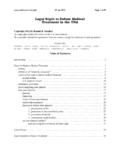Transcription of An IC Amplifier User’s Guide to Decoupling, …
1 A AN-202. APPLICATION NOTE. One Technology Way Box 9106 Norwood, MA 02062-9106 781/329-4700 World Wide Web Site: An IC Amplifier User's Guide to Decoupling, Grounding, and Making Things Go Right for a Change By Paul Brokaw There once as a breathy baboon classes, so far as the problems of power and grounding Who always breathed down a bassoon, are concerned. Although the configuration of a system For he said "It appears may pose formidable problems of decoupling and signal that in billions of years returns, some basic methods to handle many of these I shall certainly hit on a tune problems can be developed from a look at op amps.
2 (Sir Arthur Eddington). OP AMPS HAVE FOUR TERMINALS. This quotation seemed a proper note with which to begin A casual look through almost any operational Amplifier on a subject that has made monkeys of most of us at one text might leave the reader with the impression that an time or another. The struggle to find a suitable configu- ideal op amp has three terminals: a pair of differential ration for system power, ground, and signal returns too inputs and an output as shown in Figure 1. A quick review frequently degenerates into a frustrating glitch hunt.
3 Of fundamentals, however, shows that this cannot be While a strictly experimental approach can be used to the case. If the Amplifier has an output voltage it must be solve simple problems, a little forethought can often measured with respect to some point .. a point to prevent serious problems and provide a plan of attack if which the Amplifier has a reference. Since the ideal op some judicious tinkering is later required. amp has infinite common-mode rejection, the inputs are The subject is so fragmented that a completely general ruled out as that reference so that there must be a fourth treatment is too difficult for me to tackle.
4 Therefore, I'd Amplifier terminal. Another way of looking at it is that if like to state one general principle and then look a bit more the Amplifier is to supply output current to a load, that narrowly at the subject of decoupling and grounding as current must get into the Amplifier somewhere. Ideally, it relates to integrated circuit amplifiers. no input current flows, so again the conclusion is that a fourth terminal is required.. Principle: Think where the currents will flow. I suppose this seems pretty obvious, but all of us tend to think of the currents we're interested in as flowing out A.
5 Of some place and through some other place but often neglect to worry how the current will find its way back to Figure 1. Conventional "Three Terminal" Op Amp its source. One tends to act as if all ground or supply voltage points are equivalent and neglect (for as long A common practice is to say, or indicate in a diagram, as possible) the fact that they are parts of a network of that this fourth terminal is ground. Well, without get- conductors through which currents flow and develop ting into a discussion of what ground may be, we can finite voltages.
6 Observe that most integrated circuit op amps (and a lot of the modular ones as well) do not have a ground . In order to do some advance planning it is important to terminal. With these circuits the fourth terminal is one or consider where the currents originate and to where they both of the power supply terminals. There is a tempta- will return and to determine the effects of the resulting tion here to lump together both supply voltages with the voltage drops. This, in turn, requires some minimum ubiquitous ground. And, to the extent that the supply amount of understanding of what goes on inside the cir- lines really do present a low impedance at all frequencies cuits being decoupled and grounded.
7 This information within the Amplifier bandwidth, this is probably reason- may be lacking or difficult to interpret when integrated able. When the impedance requirement is not satisfied, circuits are part of the design. however, the door is left open to a variety of problems Operational amplifiers are one of the most widely used including noise, poor transient response, and oscillation. linear lCs, and fortunately most of them fall into a few REV. B. AN-202. DIFFERENTIAL-TO-SINGLE-ENDED CONVERSION positive supply have only a minor effect on the signal One fundamental requirement of a simple op amp is that an output.
8 The difference between these sensitivities can applied signal that is fully differential at the input must be result in an apparent asymmetry in the Amplifier transient converted to a single-ended output. Single-ended, that is, response. If the Amplifier is driven to produce a positive with respect to the often neglected fourth terminal. To see voltage swing across its rated load, it will draw a current how this can lead to difficulties, take a look at Figure 2. pulse from the positive supply. The pulse may result in a supply voltage transient, but the positive supply rejection V+ will minimize the effect on the Amplifier output signal.
9 In the opposite case, a negative output signal will extract a IN. current from the negative supply. If this pulse results in a +IN. glitch on the bus, the poor negative supply rejection will OUTPUT result in a similar glitch at the Amplifier output. While a CURRENT. MIRROR. positive pulse test may give the Amplifier transient response, V . a negative pulse test may actually give you a pretty good look at your negative supply line transient response, instead Figure 2. Simplified Real Op Amp of the Amplifier response! The signal flow illustrated by Figure 2 is used in several Remember that the impulse response of the power supply popular integrated circuit families.
10 Details vary, but the itself is not what is likely to appear at the Amplifier . basic signal path is the same as the 101, 741, 748, 777, Thirty or forty centimeters of wire can act like a high Q. 4136, 503, 515, and other integrated circuit amplifiers. The inductor to add a high-frequency component to the normally circuit first transforms a differential input voltage into a overdamped supply response. A decoupling capacitor differential current. This input stage function is represented near the Amplifier won't always cure the problem either, by PNP transistors in Figure 2.

















